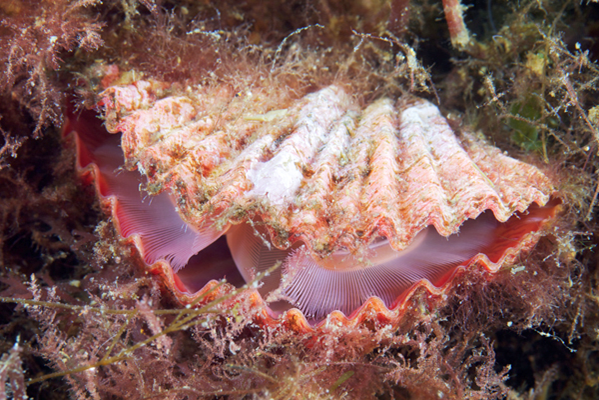by Karol McQueary
It was a great day in Los Angeles when the Southern California Paleontological Society connected with the FOSSIL Project. Our vice president, Jennifer Kerr, was contacted by Eleanor Gardner, FOSSIL Project Coordinator. Eleanor discussed the FOSSIL speaker program and its financial support in bringing professional paleontologists to speak to amateur fossil groups. Eleanor suggested that we contact Dr. Sandy Carlson of UC Davis, a professor of Paleobiology, whose research focuses on the systematics of fossil and recent brachiopods. When asked if she would be willing to fly to Los Angeles to speak to the SCPS, Dr. Carlson agreed, despite a schedule busy with her additional duties as Director of the CalTeach Mathematics and Science Teaching Programs.
After arriving in Los Angeles, Dr. Carlson and SCPS President Karol McQueary visited the Natural History Museum Invertebrate Paleontology Research and Collections Facility in Gardena. Dr. Austin Hendy, Collections Manager, gave Dr. Carlson a tour, highlighting the excellent collection of brachiopod specimens, as well as the amazing collection of Paleogene fossil insects from Georg Statz.


The next day, Dr. Carlson was the featured speaker for an enthusiastic group of more than 50 members and guests at the October SCPS meeting at the La Brea Tar Pits and Museum. She spoke on “Brachiopod Biology, Paleobiology, and Evolutionary History.” In her presentation, she described the evolutionary innovations in brachiopod development over time. She began with explaining what a brachiopod is – a bivalved lophophorate, which brings up the question, “What is a lophophore?” It is a ring of ciliated tentacles, beating in synchrony, and including a mouth and anus. It is, as Dr. Carlson puts it, the business part of the animal. Lophophores are found in living brachiopods, bryozoans, and phoronids, but evidence of lophophores in extinct brachiopods can be found in their brachial ridges and the mineralized structures that position and support the lophophore within the mantle cavity. Dr. Carlson’s study has looked at brachiopod diversity and identified evolutionary structural innovations that were successful. And what constitutes success? Of the roughly 5000 genera in 26 orders of brachiopods, 95% are extinct, leaving 5% extant and available for study. These are clearly the successful ones!
The informative presentation was well-illustrated with beautiful images of brachiopods and other lophophorates and was followed by an opportunity for questions and discussion. Our members learned much from Dr. Carlson’s presentation and were enthusiastic about a possible return visit.

The FOSSIL Project’s stated purpose is to foster learning, science, and outreach through the collaboration of professional paleontologists and the amateur paleontological community. I can truthfully say that Dr. Carlson’s presentation, supported so generously by the FOSSIL Project, achieved that purpose. Thank you Dr. Carlson, Eleanor Gardner, and the FOSSIL Project!